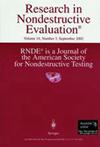Identification of Corroded Cracks in Reinforced Concrete Based on Deep Learning SCNet Model
IF 1.6
4区 材料科学
Q3 MATERIALS SCIENCE, CHARACTERIZATION & TESTING
引用次数: 1
Abstract
ABSTRACT In order to improve the efficiency and accuracy of corroded cracks detection and classification in reinforced concrete, a corroded cracks identification model Steel Corrosion Net (SCNet), based on deep learning Convolutional Neural Network (CNN), is proposed. Crack figures are collected by self-shooting, internet search and corrosion test, then the data set of 39,000 pictures is built by data enhancement. Afterward, a SCNet three-classification neural network model is built and tested using TensorFlow learning framework and Python. The SCNet combines massive initial data with a multi hidden layer neural network framework, and achieves feature learning and accurate classification through model training. According to the training and testing accuracy of the model, the structure and parameters of the SCNet network are optimized. The results of SCNet are compared with those obtained by two traditional testing methods. The results show that the proposed SCNet model achieves a classification accuracy of 96.8%, so it can effectively identify and classify the corroded cracks in reinforced concrete, with high accuracy and measurability. Under harsh condition of noise interference, such as shadows and distortions, the proposed SCNet model shows a relatively stable classification performance compared with two traditional methods.基于深度学习SCNet模型的钢筋混凝土腐蚀裂缝识别
摘要为了提高钢筋混凝土腐蚀裂缝检测与分类的效率和准确性,提出了一种基于深度学习卷积神经网络(CNN)的腐蚀裂缝识别模型钢腐蚀网(SCNet)。通过自拍照、网络搜索、腐蚀试验等方法收集裂纹图,通过数据增强建立了39000张图片的数据集。随后,利用TensorFlow学习框架和Python构建了SCNet三分类神经网络模型并进行了测试。SCNet将海量初始数据与多层隐层神经网络框架相结合,通过模型训练实现特征学习和准确分类。根据模型的训练和测试精度,对SCNet网络的结构和参数进行了优化。将SCNet测试结果与两种传统测试方法的测试结果进行了比较。结果表明,所提出的SCNet模型分类准确率达到96.8%,能够有效地对钢筋混凝土腐蚀裂缝进行识别和分类,具有较高的准确率和可测量性。在阴影和失真等噪声干扰的恶劣条件下,与两种传统方法相比,所提出的SCNet模型具有相对稳定的分类性能。
本文章由计算机程序翻译,如有差异,请以英文原文为准。
求助全文
约1分钟内获得全文
求助全文
来源期刊

Research in Nondestructive Evaluation
工程技术-材料科学:表征与测试
CiteScore
2.30
自引率
0.00%
发文量
14
审稿时长
>12 weeks
期刊介绍:
Research in Nondestructive Evaluation® is the archival research journal of the American Society for Nondestructive Testing, Inc. RNDE® contains the results of original research in all areas of nondestructive evaluation (NDE). The journal covers experimental and theoretical investigations dealing with the scientific and engineering bases of NDE, its measurement and methodology, and a wide range of applications to materials and structures that relate to the entire life cycle, from manufacture to use and retirement.
Illustrative topics include advances in the underlying science of acoustic, thermal, electrical, magnetic, optical and ionizing radiation techniques and their applications to NDE problems. These problems include the nondestructive characterization of a wide variety of material properties and their degradation in service, nonintrusive sensors for monitoring manufacturing and materials processes, new techniques and combinations of techniques for detecting and characterizing hidden discontinuities and distributed damage in materials, standardization concepts and quantitative approaches for advanced NDE techniques, and long-term continuous monitoring of structures and assemblies. Of particular interest is research which elucidates how to evaluate the effects of imperfect material condition, as quantified by nondestructive measurement, on the functional performance.
 求助内容:
求助内容: 应助结果提醒方式:
应助结果提醒方式:


